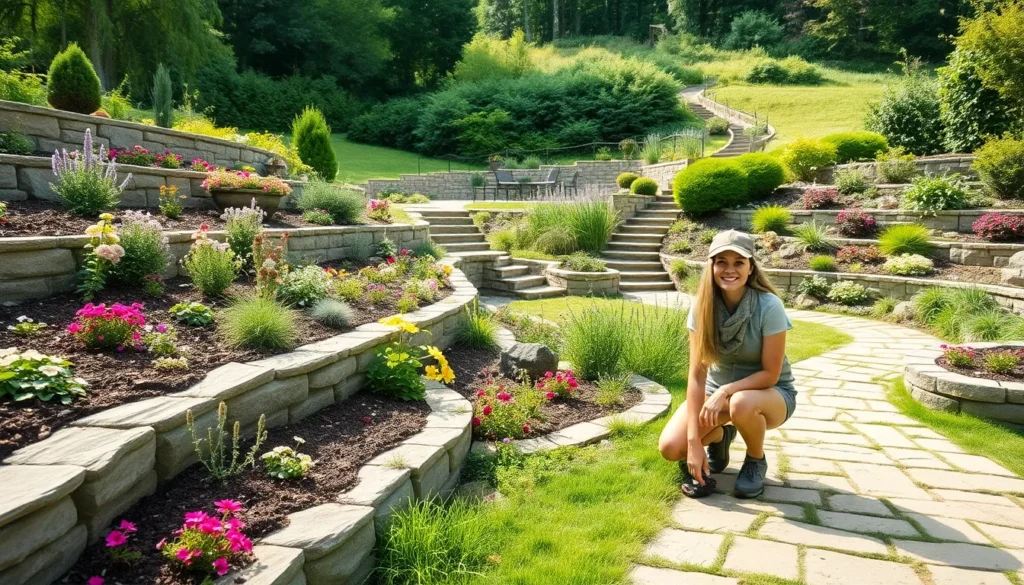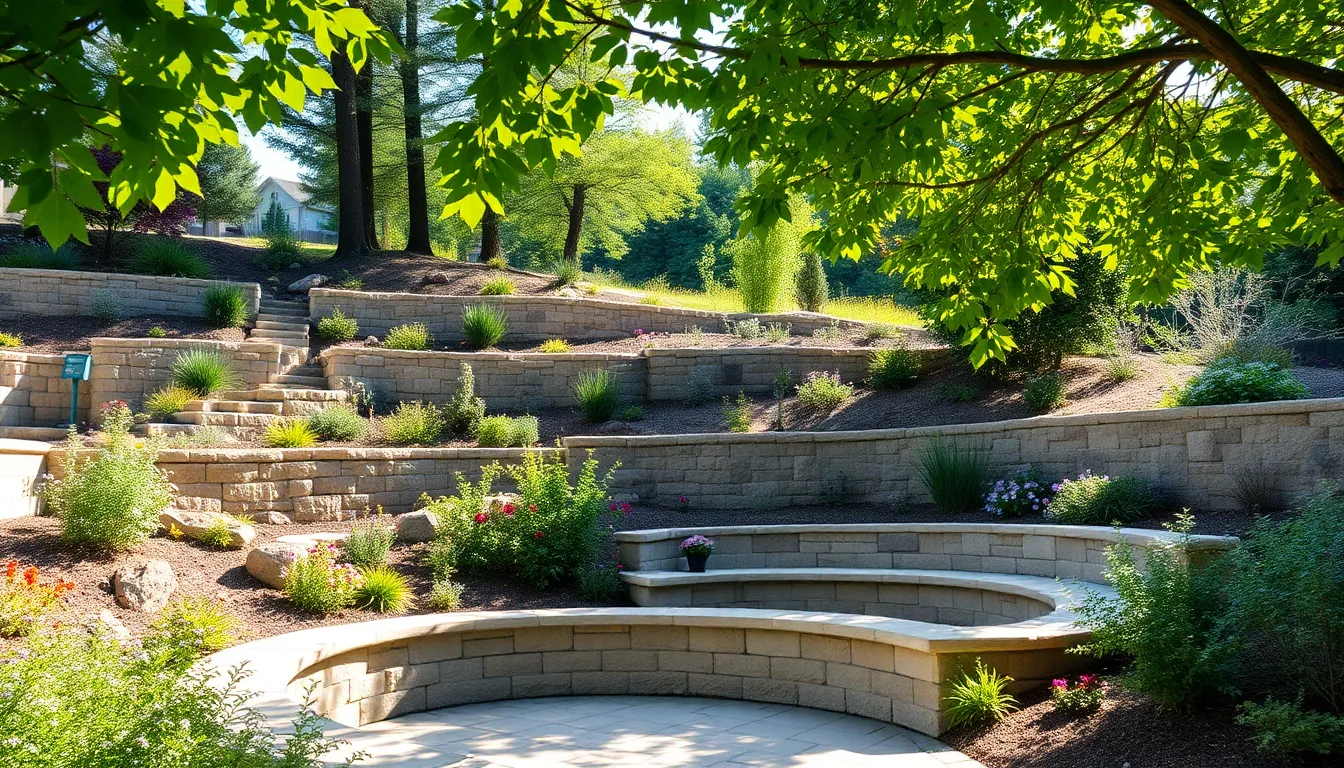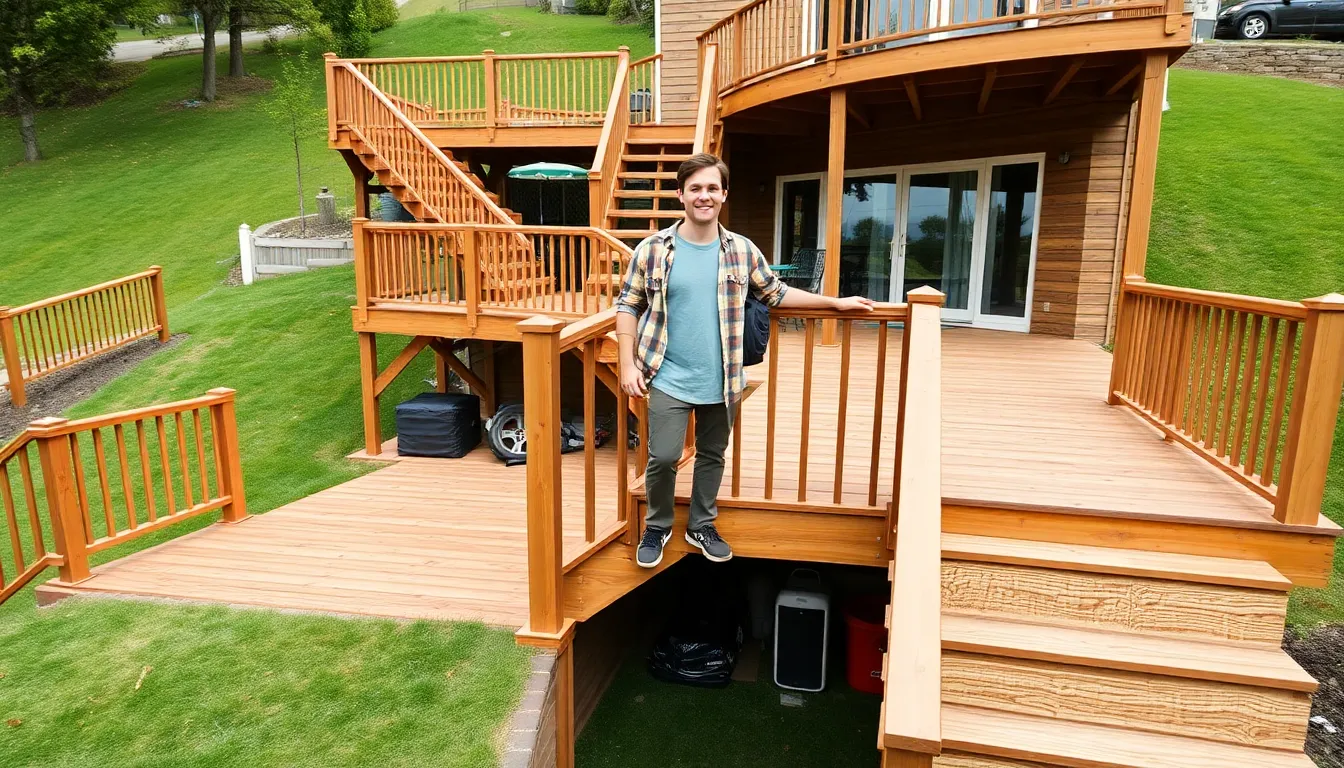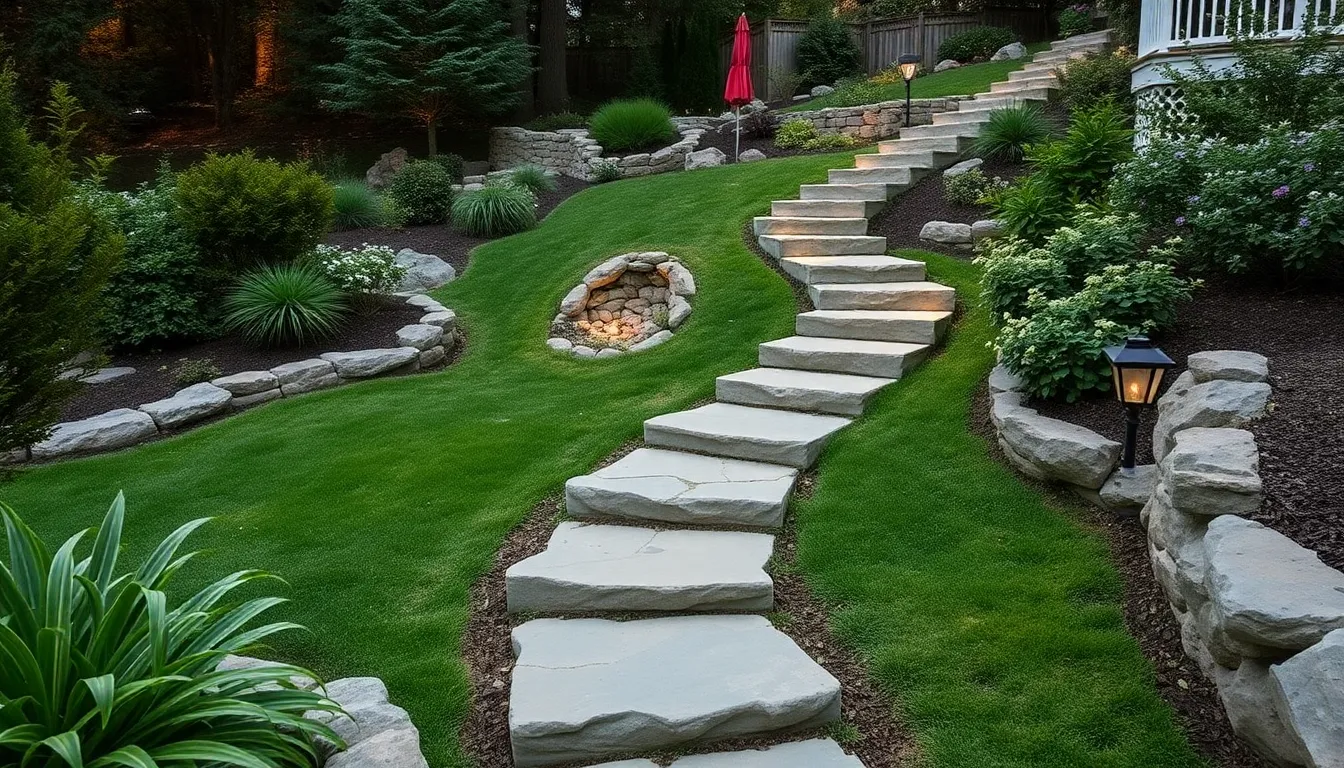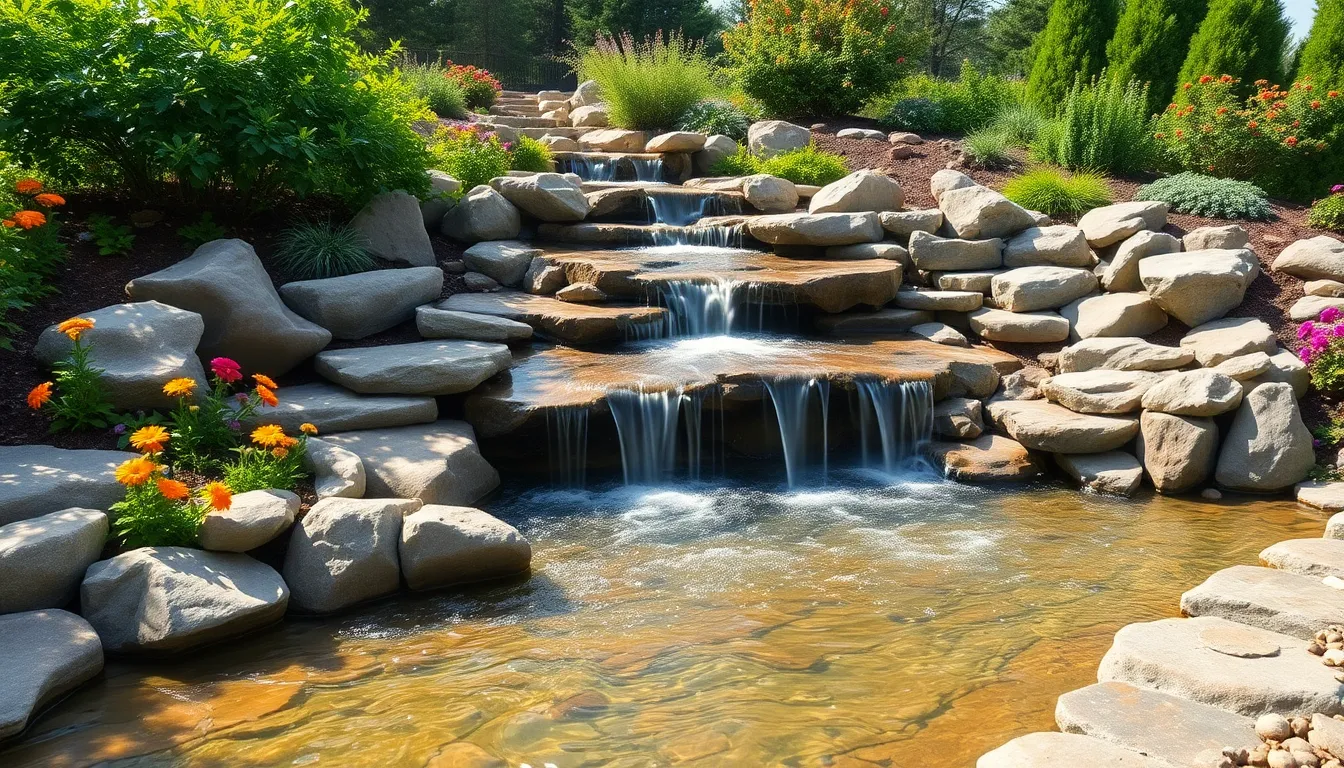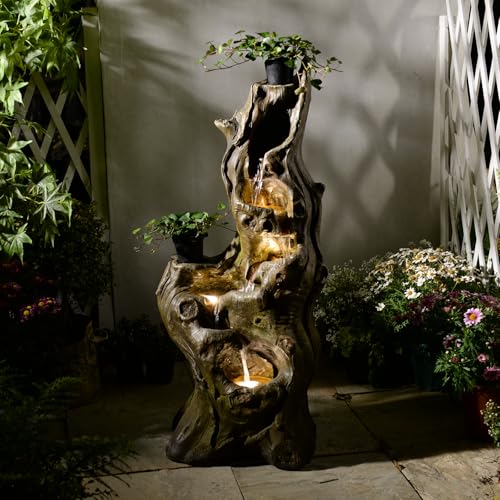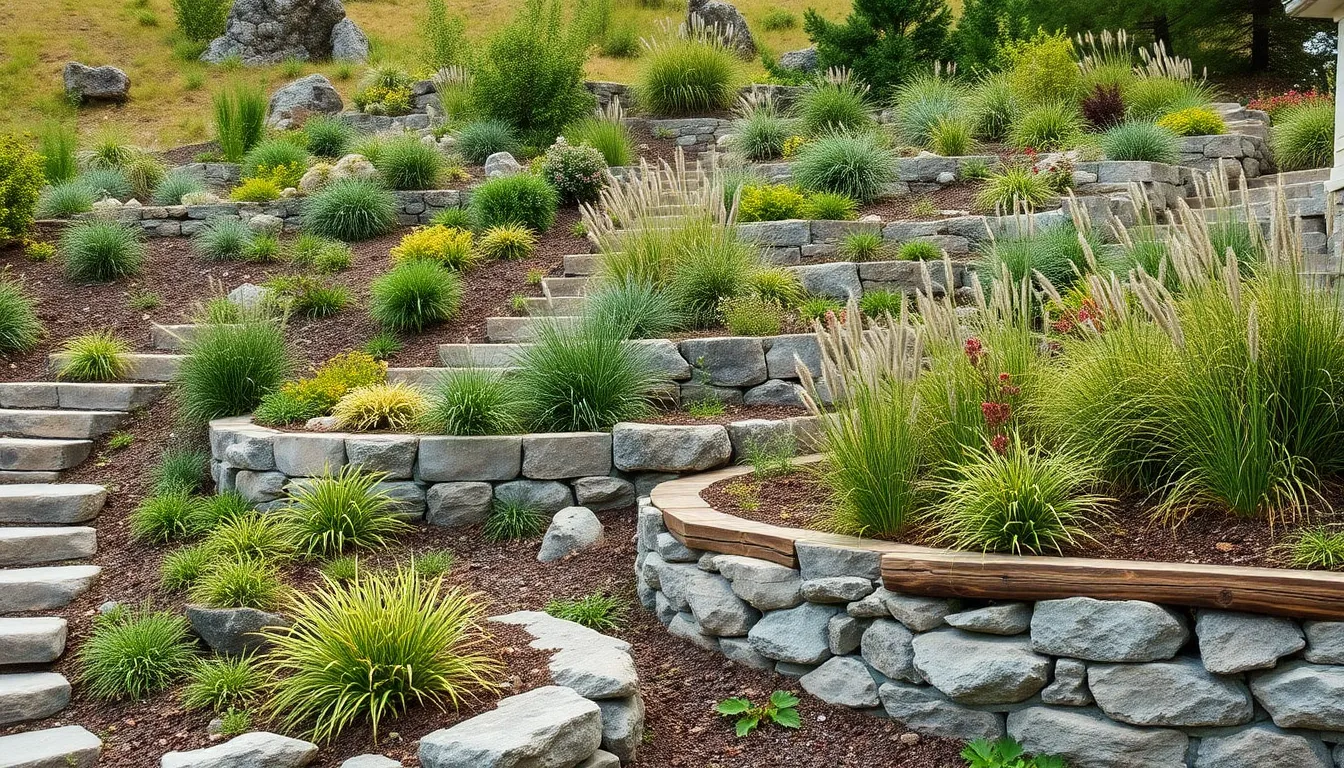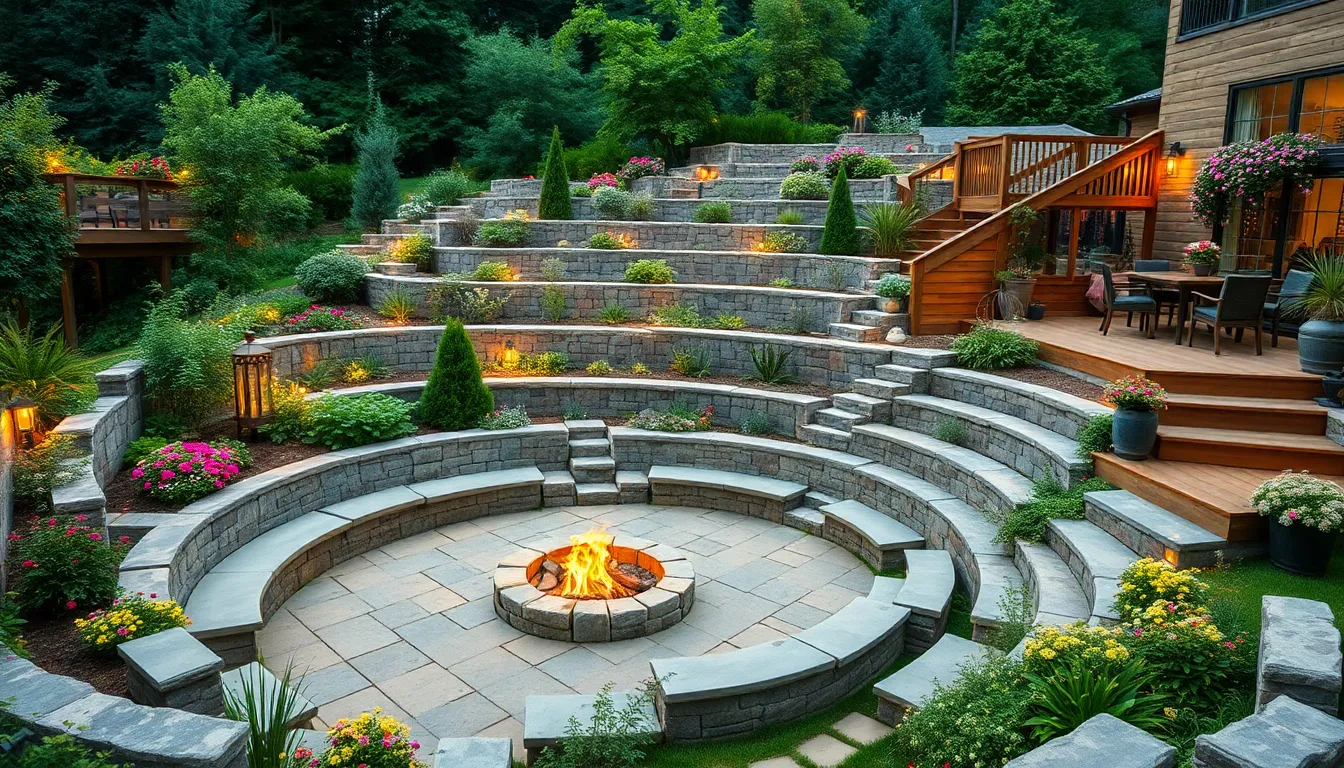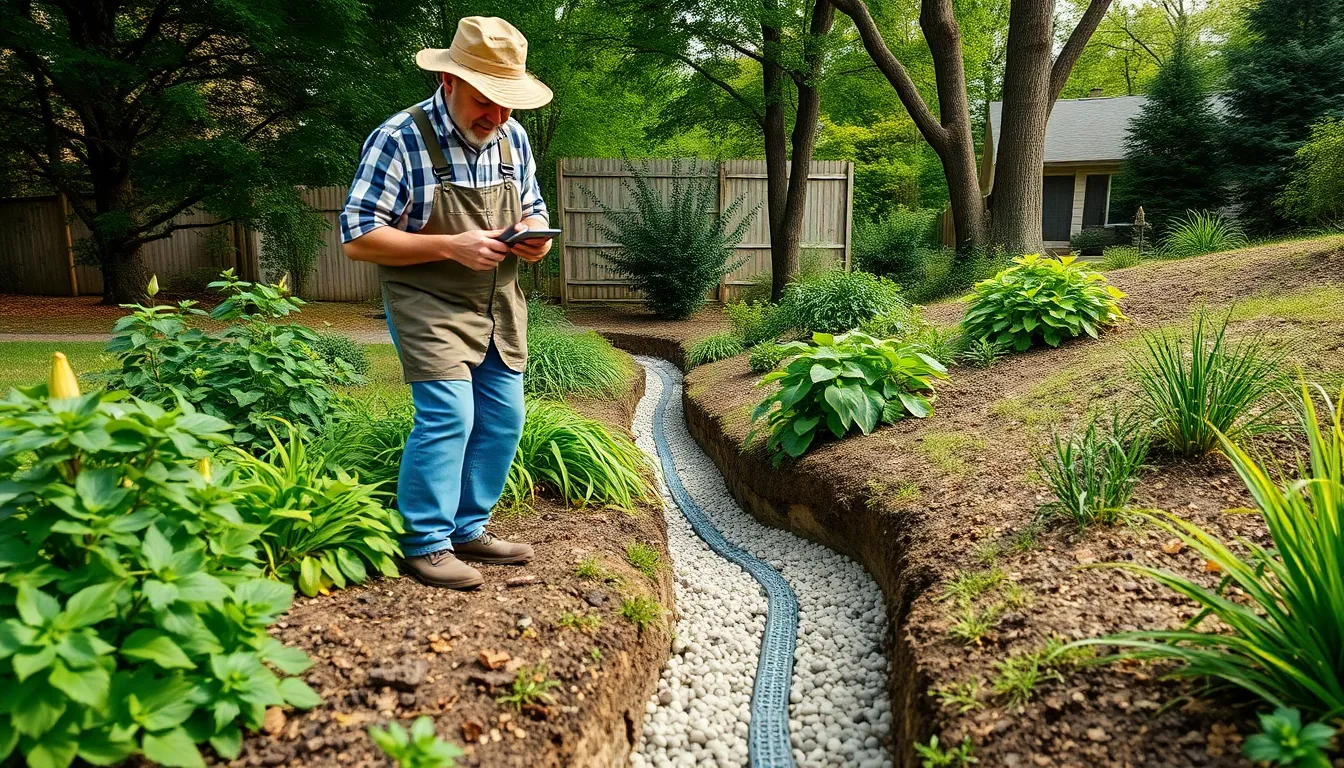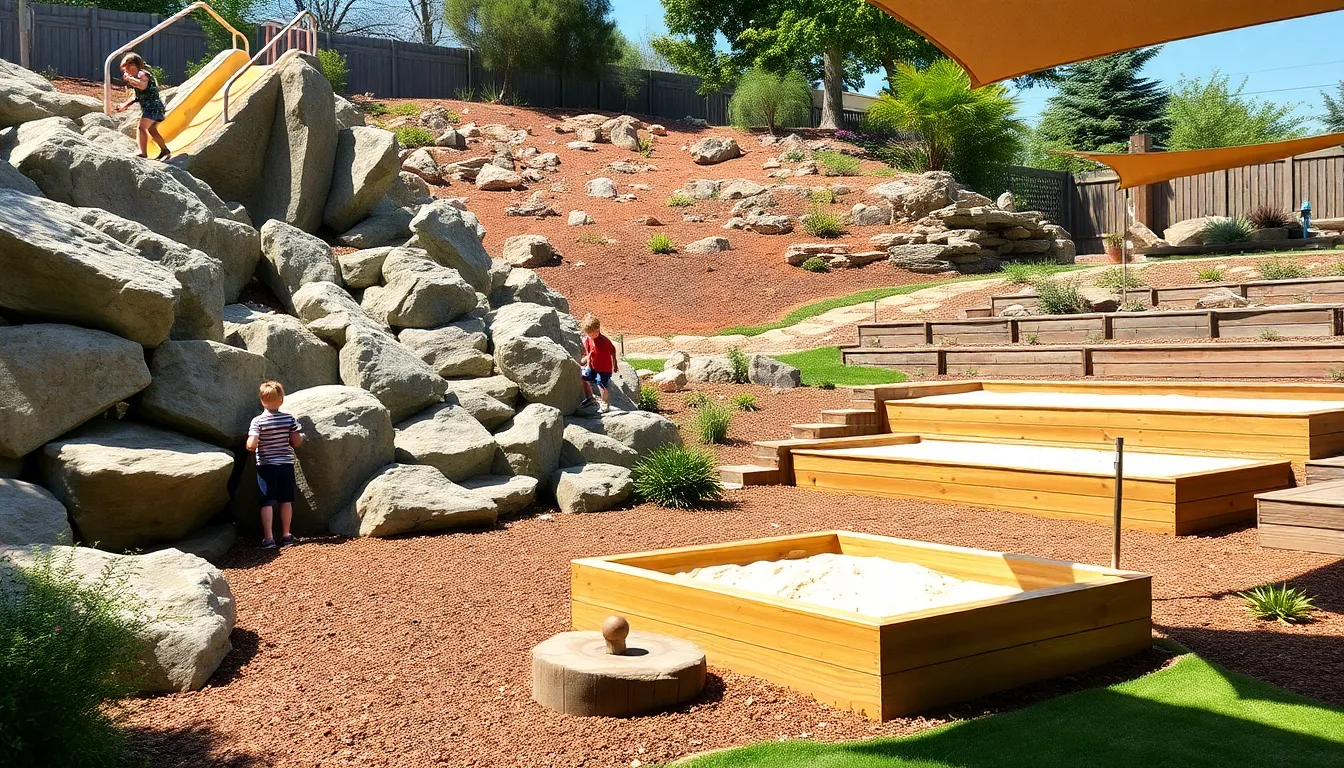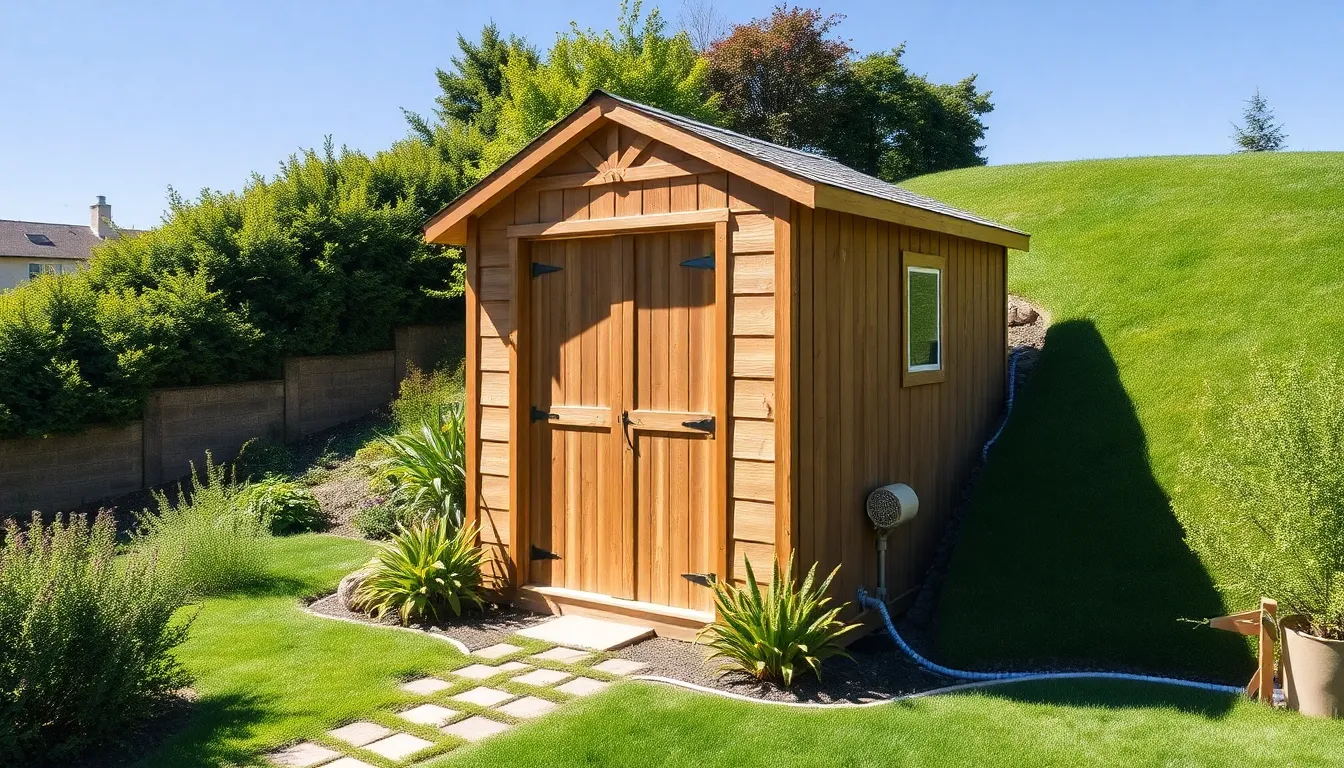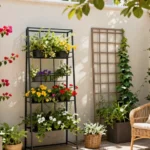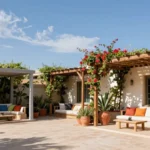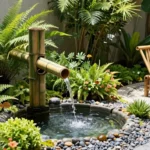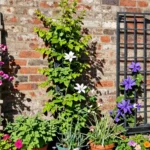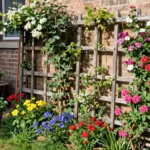Transforming a sloped backyard from a challenging eyesore into a stunning outdoor oasis isn’t just possible—it’s one of the most rewarding landscaping projects we can tackle. Many homeowners view their uneven terrain as a limitation but we see it as an opportunity to create something truly extraordinary that flat yards simply can’t achieve.
Sloped yards offer unique advantages that we can leverage to build multi-level gardens, dramatic retaining walls, and cascading water features that add depth and visual interest to our outdoor spaces. With the right approach, these challenging slopes become the foundation for terraced gardens, winding pathways, and cozy seating areas that maximize every square foot of our property.
We’ve discovered that working with nature’s natural contours rather than fighting against them creates more ever-changing and cost-effective answers. Whether we’re dealing with gentle inclines or steep hillsides, there are proven strategies that turn problematic slopes into our backyard’s most captivating features.
Transform Your Sloped Yard With Terraced Garden Beds
Terraced garden beds turn challenging slopes into stunning multi-dimensional landscapes that maximize both growing space and visual impact.
Create Multi-Level Planting Areas
Designing tiered planting zones allows us to use every inch of our sloped terrain while creating distinct garden rooms. We can establish three to five separate levels depending on our yard’s gradient, with each terrace serving a exact purpose like vegetables, flowers, or herbs. Plant placement becomes strategic when we position taller specimens like shrubs and small trees on upper levels to create natural windbreaks for delicate plants below.
Spacing between terraces should measure 3 to 6 feet to provide adequate growing room and easy maintenance access. We’ll want to consider sun exposure patterns across our slope since upper terraces typically receive more direct sunlight than lower areas. Water naturally flows downward, so we can take advantage of this drainage pattern by placing water-loving plants like hostas and ferns on lower terraces.
Use Retaining Walls for Structure
Building retaining walls creates the foundation for stable terraced beds that prevent soil erosion and provide long-term structural integrity. We can choose from materials like natural stone, concrete blocks, or treated timber depending on our budget and aesthetic preferences. Wall height should remain under 4 feet per tier to avoid requiring special engineering permits in most areas.
Proper drainage behind retaining walls prevents water buildup that could cause structural failure over time. We need to install gravel backfill and drainage pipes behind walls taller than 2 feet. French drains at the base of each wall system help redirect excess water away from our terraced beds during heavy rainfall periods.
Install Stepped Stone Borders
Stone borders define each terrace level while providing attractive edging that complements our overall industry design. We can use flagstone, fieldstone, or cut stone blocks to create clean lines between planting areas and pathways. Border stones should extend 2 to 4 inches above soil level to contain mulch and prevent erosion during watering.
Installing borders requires excavating a shallow trench and laying a sand base for stability. We should select stones that match our home’s exterior materials or existing hardscape features for design continuity. Stepped stone arrangements work particularly well when we vary the stone sizes to create natural-looking transitions between terrace levels.
Build Strategic Retaining Walls for Stability
Building retaining walls becomes essential when we’re working with sloped terrain that needs structure and stability. These walls prevent soil erosion while creating functional terraced spaces that transform unusable slopes into beautiful outdoor living areas.
Choose Natural Stone Materials
Natural stone materials offer the perfect combination of durability and aesthetic appeal for our retaining wall projects. Flagstone provides excellent texture and color variation that complements most home exteriors. Limestone creates a classic, timeless look while offering superior weather resistance in various climates. Fieldstone brings rustic charm and blends seamlessly with natural landscapes.
We recommend these materials because they require less maintenance compared to manufactured alternatives. Stone walls age gracefully and develop character over time rather than showing wear. The organic textures and earth tones enhance our yard’s natural beauty while providing the structural integrity needed for long term stability.
Design Curved Wall Patterns
Curved retaining walls soften the harsh lines that straight walls can create in sloped yards. These flowing patterns follow the natural contours of our terrain, making the design feel more harmonious and inviting. Curves help define different zones within the yard while maintaining visual continuity throughout the space.
We find that curved walls create more interesting sight lines and encourage exploration of different areas. The gentle arcs break up large expanses and add movement to the industry design. This approach also allows us to work with existing trees and natural features rather than fighting against them.
Incorporate Built-In Seating
Built-in seating transforms our retaining walls into multifunctional outdoor living spaces. These integrated benches maximize functionality without requiring additional square footage in our terraced areas. We can create comfortable gathering spots at different elevations throughout the sloped yard.
Seating walls typically measure 18 to 24 inches in height for optimal comfort. Adding cushions or weather resistant pillows makes these spaces even more inviting for relaxation and socializing. This feature encourages us to actually use and enjoy our transformed slope rather than simply viewing it from a distance.
Design Multi-Level Deck Systems
Multi-level decks transform challenging slopes into functional outdoor living spaces by creating usable flat areas at different elevations. We can maximize our yard’s potential by building strategic deck systems that work with the natural terrain rather than against it.
Connect Different Elevation Points
Installing stairs becomes essential for safely linking different deck levels in our sloped yards. We recommend building pathways that flow naturally between elevation changes, making every area of our outdoor space accessible. Gently sloping ramps offer an alternative to traditional steps, providing better accessibility for wheelchairs or those with mobility challenges.
Lighting along these connection routes enhances both safety and visual appeal during evening hours. We should consider adding handrails to all transitional areas, ensuring secure passage between different deck levels. Strategic placement of these connectors helps create a cohesive flow throughout our multi-level design.
Add Railings for Safety
Railings prevent dangerous falls from raised platforms and steep deck areas in our sloped backyards. We must install proper safety barriers on all elevated surfaces, especially where drops exceed 30 inches. Wood railings complement traditional deck designs, while metal options provide modern aesthetics and durability.
Cable railings offer unobstructed views while maintaining essential safety standards. We can choose materials that match our home’s exterior style, creating visual harmony between indoor and outdoor spaces. Proper railing height should meet local building codes, typically ranging from 36 to 42 inches for residential applications.
Include Storage Underneath
Converting the space beneath our multi-level decks creates valuable storage for outdoor equipment and furniture. We can install weatherproof enclosures to protect garden tools, cushions, and seasonal decorations from the elements. Lattice panels provide attractive screening while allowing air circulation around stored items.
Built-in storage compartments maximize organization while keeping our deck areas clutter-free. We should consider adding shelving systems or hooks for efficient use of this hidden space. Proper ventilation prevents moisture buildup that could damage stored belongings or create mold issues.
Install Stepped Walkways and Pathways
Stepped walkways provide safe and convenient access between different yard elevations while minimizing erosion and soil displacement. These pathways create essential connections between your outdoor spaces, transforming challenging slopes into functional and inviting areas.
Use Natural Stone Steps
Natural stone steps offer the perfect combination of durability and aesthetic appeal for sloped yards. Flagstone, limestone, and fieldstone blend seamlessly with garden elements while promoting a natural look that complements your existing industry design.
Materials that work best include:
- Flagstone for its flat surface and natural beauty
- Limestone for its weather resistance and elegant appearance
- Fieldstone for rustic charm and organic integration
We recommend selecting stones that match your home’s exterior and surrounding environment. Proper drainage behind each step ensures longevity and prevents water damage during heavy rains. Stone steps can create tiered terraces or smooth transitions between different yard levels, improving the overall visual flow of your industry.
Create Winding Garden Paths
Winding garden paths work exceptionally well in uneven terrain by gently guiding visitors through your space while minimizing steep climbs. These curved pathways add softness and natural flow to your industry, breaking up harsh slope lines and creating serene garden experiences.
Popular materials for winding paths include:
- Gravel for drainage and easy maintenance
- Mulch for natural integration with plantings
- Flagstones for elegant, long-lasting surfaces
We suggest integrating planting pockets along the route to create visual interest and natural stopping points. Curved paths encourage exploration while making steep areas more manageable for foot traffic. The gentle curves also help visitors navigate elevation changes without feeling the strain of direct uphill climbs.
Add Lighting for Evening Use
Strategic lighting along steps, pathways, and terraces extends your backyard’s usability into evening hours while improving safety and visual appeal. Well-planned illumination highlights key industry features and creates an inviting ambiance for nighttime entertaining.
Effective lighting options include:
- Low-voltage path lights for safe navigation
- Recessed step lights for precise illumination
- Accent lighting on plants and water features
We recommend focusing on safety-critical areas like step edges and path transitions where visibility matters most. Lighting also transforms your sloped yard into an attractive evening focal point, showcasing the natural beauty of your stepped walkways and garden paths after dark.
Create Dramatic Water Features on Slopes
Water features transform sloped backyards into captivating outdoor sanctuaries by leveraging gravity’s natural power. We’ll explore three stunning approaches that turn challenging terrain into spectacular focal points.
Build Cascading Waterfalls
Cascading waterfalls serve as stunning centerpieces for sloped yards by utilizing gravity to enhance water movement naturally. Natural stones create seamless integration with your existing industry while producing soothing sounds that mask neighborhood noise. Position larger boulders at the top of your slope to create the primary water source, then arrange medium-sized rocks in a staggered pattern down the incline.
Proper drainage prevents water accumulation that could destabilize your slope over time. Size your waterfall system according to your yard’s dimensions and water pressure capabilities to ensure consistent flow throughout the seasons. Install a recirculating pump system at the base to maintain continuous water movement while conserving resources.
Strategic lighting transforms your waterfall into a nighttime spectacle that extends your outdoor enjoyment hours. Submersible LED lights positioned behind falling water create dramatic silhouettes, while uplighting on surrounding plants adds depth to the overall display.
Install Terraced Fountain Systems
Terraced fountain systems maximize your slope’s vertical space by creating multiple water levels that flow from one basin to the next. Each terrace level serves as both a water feature and a potential planting area for moisture-loving vegetation. Design your fountain system with varying basin sizes to create visual interest and accommodate different water flow rates.
Water flows naturally from upper terraces to lower ones, creating a gentle cascade effect that manages runoff while adding aesthetic appeal. Incorporate overflow channels between levels to handle heavy rainfall and prevent water damage to surrounding areas. Consider installing automatic water level sensors to maintain optimal water levels in each basin.
Integrated lighting systems illuminate each terrace level individually, allowing you to customize the ambiance for different occasions. Solar-powered options reduce installation complexity while providing eco-friendly operation that doesn’t increase your energy costs.
Design Natural Stream Beds
Natural stream beds mimic mountain streams flowing downhill by using river rocks, native plants, and your yard’s natural contours. Create meandering paths that follow your slope’s natural grade rather than forcing straight lines that can cause erosion. Line your stream bed with a combination of large anchor stones and smaller river rocks to create varied water sounds and flow patterns.
Incorporate water-loving plants like ferns, hostas, and ornamental grasses along stream edges to integrate the feature seamlessly into your industry. These plants thrive in the moist environment while providing natural erosion control through their root systems. Choose native species that require minimal maintenance once established.
Install check dams using larger stones at regular intervals to slow water flow during heavy rains and create small pools that attract wildlife. Position these features strategically to prevent soil displacement while creating opportunities for aquatic plants and beneficial insects to establish themselves.
Establish Ground Cover for Erosion Control
Ground cover plants serve as your first line of defense against soil erosion on sloped terrain. These hardy, low-growing plants spread quickly to stabilize bare soil with their extensive root systems while creating a protective layer that reduces water runoff.
Plant Native Slope-Friendly Plants
Native plants offer the perfect solution for challenging slope conditions since they’ve naturally adapted to local climate and soil requirements. We recommend selecting drought-resistant species with deep root systems that can effectively anchor soil and prevent erosion. Varieties like native wildflowers, shrubs, and perennials not only require minimal maintenance but also enhance your yard’s biodiversity while providing year-round visual appeal.
Choose plants that thrive in your exact region’s conditions, focusing on species that can handle poor drainage, rocky soil, or steep angles. Deep-rooted varieties like native sedums, wild bergamot, or regional prairie grasses create natural stabilization networks beneath the surface. These selections establish themselves quickly and spread naturally to cover vulnerable areas where erosion typically occurs.
Use Ornamental Grasses
Ornamental grasses excel on slopes because their fibrous root systems create dense networks that bind soil particles together effectively. These versatile plants add texture, movement, and seasonal interest to your industry while tolerating poor soil conditions and drought. Varieties like fountain grass, feather reed grass, and blue fescue establish quickly and require minimal care once rooted.
Grasses provide year-round structure and movement that changes with the seasons and weather conditions. Their natural ability to bend without breaking makes them ideal for windy slope locations where other plants might struggle. Many ornamental grass species also offer attractive seed heads and foliage color changes that extend visual interest beyond the growing season.
Install Living Retaining Systems
Living retaining systems combine structural support with natural vegetation to create highly effective slope stabilization answers. These systems typically include terraced garden beds supported by stone, wood, or concrete walls that hold soil in place while providing planting areas. We integrate pathways and stepped access points to enhance usability and create functional outdoor spaces from previously unusable steep areas.
Tiered garden beds allow you to create distinct planting zones with different themes or plant types at each level. Stone or timber retaining walls provide the structural integrity needed to prevent soil movement while creating attractive borders for your plantings. These systems reduce erosion by controlling water flow and creating flat planting surfaces that are easier to maintain and access.
Consider incorporating built-in drainage systems within your living retaining walls to manage water flow and prevent saturation issues. Strategic placement of these systems can create multiple garden rooms that maximize your slope’s potential while providing long-term stability and visual appeal.
Build Outdoor Living Spaces at Different Levels
Building outdoor living spaces at different levels transforms sloped terrain into functional zones that maximize your backyard’s potential. We’ll explore three strategic approaches that convert challenging slopes into inviting entertainment areas.
Design Sunken Fire Pit Areas
Excavating a sunken fire pit creates a naturally sheltered gathering space that takes advantage of your slope’s natural contours. We recommend digging into the lower section of your uneven ground to form a cozy depression that feels intimate and protected from wind.
Arranging seating on multiple tiers around the pit enhances the social experience while working with your yard’s existing grade. Terraced stone benches or built-in seating at different elevations encourage conversation and allow guests to find their preferred viewing angle.
Installing proper drainage beneath the sunken area prevents water accumulation during heavy rains. We suggest adding a gravel base and perimeter drainage to keep your fire pit functional year-round.
Create Elevated Dining Platforms
Constructing elevated dining decks provides flat surfaces for entertaining while capitalizing on the enhanced views that sloped backyards naturally offer. Wood or composite materials work best for these platforms, offering durability and design flexibility.
Connecting platforms with steps or ramps ensures easy access between different yard levels. We recommend building wide, gradual steps that feel welcoming rather than challenging, especially when carrying food or entertaining guests.
Integrating railings and lighting into elevated platforms enhances both safety and ambiance for evening dining. Strategic placement of these elements maintains open sight lines while providing necessary protection on raised surfaces.
Install Multi-Tier Entertainment Zones
Creating distinct zones through terracing adds variety and function to your uneven backyard. We suggest designating exact areas for lounging, play spaces, gardens, and dining to maximize your yard’s entertainment potential.
Linking zones with well-designed pathways and steps creates seamless flow throughout your multi-level space. Stone or brick pathways work particularly well as they blend naturally with outdoor surroundings while providing stable walking surfaces.
Improving each tier with appropriate lighting and plantings improves both safety and atmosphere during evening use. Drought-tolerant plants require less maintenance on terraced areas, while strategic lighting highlights level changes and creates visual interest after dark.
Implement Creative Drainage Solutions
Managing water flow becomes crucial when working with sloped terrain to prevent erosion and protect your investment. We’ll explore three proven drainage methods that transform challenging slopes into functional outdoor spaces.
Install French Drain Systems
French drains offer the most reliable solution for redirecting groundwater away from problem areas on sloped properties. These systems consist of trenches filled with gravel containing perforated pipes that collect and channel water naturally downward.
Installing a French drain requires digging trenches along the slope’s contour, typically 12-18 inches deep and 6 inches wide. We recommend wrapping the perforated pipe with industry fabric to prevent soil infiltration while maintaining water flow. The trench should maintain a consistent 1% grade to ensure proper drainage toward your designated outlet point.
Combining French drains with retaining walls creates an exceptionally effective drainage system. The gravel-filled gaps between retaining wall sections allow water to flow through while the French drain captures and redirects excess groundwater away from structures.
Proper grading remains essential when installing French drains, with soil sloping away from your home’s foundation at a minimum 3% grade. This technique works particularly well when integrated with other slope management answers like terraced gardens or stepped pathways.
Create Rain Gardens
Rain gardens transform low-lying areas of your slope into beautiful, functional water management features. These shallow planted depressions capture runoff naturally while promoting water infiltration into the soil rather than allowing harmful erosion.
Positioning rain gardens strategically in natural collection points maximizes their effectiveness. We suggest placing them 10-20 feet away from your home’s foundation to prevent water from pooling near structures. The garden should be approximately 20-30% the size of the drainage area feeding into it.
Native, water-tolerant plants form the backbone of successful rain gardens. Species like blue flag iris, cardinal flower, and native sedges thrive in these conditions while providing year-round visual interest. These plants develop extensive root systems that improve soil stability and water absorption capacity.
Designing your rain garden with gentle side slopes of 3:1 or less ensures safety and accessibility for maintenance. We recommend creating overflow channels using rocks or gravel to handle extreme rainfall events while maintaining the garden’s aesthetic appeal.
Use Permeable Hardscaping Materials
Permeable hardscaping materials allow rainwater to infiltrate through surfaces instead of creating damaging runoff on slopes. Porous pavers, permeable concrete, and gravel pathways reduce surface water flow while maintaining attractive, functional outdoor spaces.
Installing permeable pavers requires proper base preparation with multiple layers of graded gravel for optimal drainage performance. The base typically consists of 4-6 inches of angular gravel topped with 1-2 inches of fine stone dust for leveling and stability.
Gravel pathways provide the most cost-effective permeable hardscaping option for sloped yards. We suggest using ¾-inch crushed stone for high-traffic areas and pea gravel for decorative applications. Installing industry edging prevents gravel migration while maintaining clean pathway borders.
Combining permeable materials with dry creek beds creates natural-looking drainage channels that handle water flow beautifully. These features use rocks and gravel to mimic natural stream beds while directing water safely through your industry during heavy rainfall events.
Design Unique Play Areas for Sloped Yards
Creating captivating play spaces on uneven terrain allows us to transform challenging slopes into ever-changing outdoor entertainment zones. We can capitalize on natural elevation changes to design interactive features that children will love while maximizing our yard’s unique topography.
Build Natural Climbing Features
Natural climbing features take advantage of your slope’s existing terrain to create exciting play opportunities. We recommend incorporating large boulders, rock formations, or sturdy retaining walls that double as climbing structures for children to explore safely. Strategic placement of these features along different elevation points creates multiple challenge levels that grow with your kids.
Integrating native plantings around climbing areas enhances both safety and visual appeal while providing natural handholds and footholds. We suggest adding industry lighting to illuminate these features during evening hours, extending playtime and improving visibility for parents supervising activities. Stone retaining walls serve dual purposes by preventing erosion while offering textured surfaces perfect for climbing adventures.
Create Hillside Slides
Hillside slides transform your slope’s natural incline into an exciting play feature that works with the terrain rather than against it. We can carve gentle channels into the hillside or install commercial slide structures that follow the slope’s natural contours. These installations become integrated industry elements that encourage active outdoor play while maintaining the yard’s aesthetic appeal.
Terraced landing areas at the bottom of slides provide safe stopping zones and additional play spaces for multiple children. We recommend using durable materials like stainless steel or high-density polyethylene that withstand weather exposure and heavy use. Surrounding the slide area with soft landscaping or mulch creates natural cushioning and helps blend the feature into the overall yard design.
Install Terraced Sandbox Areas
Terraced sandbox areas use multiple elevation levels to create distinct play zones that prevent sand migration down the slope. We can construct tiered sandbox spaces using retaining walls or raised bed structures that contain sand while adding visual interest to the industry. Each terrace level serves as a separate activity area, allowing multiple children to play simultaneously without crowding.
Installing proper drainage beneath each sandbox prevents water accumulation and maintains sand quality throughout different weather conditions. We suggest using cedar or composite materials for sandbox borders as they resist moisture damage and provide smooth edges for safe play. Strategic placement of shade structures over terraced areas protects children from sun exposure while keeping sand cool during hot summer days.
Maximize Storage With Slope-Integrated Solutions
We can transform sloped terrain challenges into functional storage opportunities by incorporating structures that work with our yard’s natural contours. Clever slope integration maximizes space efficiency while maintaining aesthetic appeal.
Build Hillside Storage Sheds
Hillside storage sheds blend seamlessly into sloped terrain while providing essential storage space. We construct these structures directly into the hillside, using the natural incline as part of the foundation system. This approach saves valuable yard space while creating ample room for garden tools, seasonal equipment, and outdoor supplies.
Drainage systems prevent moisture damage in hillside installations. We install proper French drains around the structure’s perimeter to redirect groundwater away from stored items. Waterproof membranes behind the shed walls protect against soil moisture infiltration.
Structural reinforcement ensures stability against soil pressure. We use concrete footings anchored deep into stable soil layers, preventing shifting from uphill earth movement. Steel reinforcement bars strengthen foundation walls that bear against natural hillside pressure.
Access design considers safety and convenience for sloped installations. We create level entry platforms with non slip surfaces, connecting to existing walkways through stepped pathways. Wide door openings accommodate lawn equipment and bulk storage items.
Create Under-Deck Storage
Under deck storage transforms wasted space into valuable organizational areas. We use the protected area beneath elevated decks on slopes, creating weatherproof storage for bulky items like patio furniture, gardening supplies, and seasonal decorations. This enclosed space stays naturally dry while remaining easily accessible.
Enclosure options provide security and weather protection. We install sliding panel doors made from cedar or composite materials that match existing deck aesthetics. Lattice screens offer ventilation while maintaining visual appeal and allowing air circulation around stored items.
Accessibility features improve storage functionality. We add built in shelving systems along the back wall, creating organized zones for different item categories. Pull out drawer systems maximize deep storage areas while keeping items within easy reach.
Moisture control prevents damage to stored belongings. We install vapor barriers on concrete surfaces and ensure proper ground grading directs water away from the storage area. Ventilation gaps prevent condensation buildup during temperature changes.
Design Retaining Wall Storage
Retaining wall storage combines structural necessity with practical functionality. We integrate built in storage compartments directly into retaining wall construction, creating dual purpose structures that manage soil erosion while providing organized storage space. These walls serve multiple functions without requiring additional yard footprint.
Built in shelving maximizes vertical storage potential. We create recessed niches within retaining wall thickness, installing weatherproof shelving for garden tools, potting supplies, and outdoor maintenance equipment. Stone or concrete shelves blend naturally with wall materials while supporting substantial weight.
Bench seating incorporates hidden storage compartments. We design retaining wall caps as comfortable seating areas with lift up lids accessing storage space below. These bench designs provide relaxing spots to enjoy yard views while concealing pool supplies, cushions, or garden accessories.
Drainage integration prevents water damage in storage areas. We install weep holes behind storage compartments, allowing water to drain away from stored items. Sloped compartment floors direct moisture toward drainage outlets, keeping contents dry during heavy rainfall.
| Storage Solution | Space Efficiency | Weather Protection | Accessibility Rating |
|---|---|---|---|
| Hillside Sheds | High | Excellent | Good |
| Under-Deck Storage | Very High | Excellent | Very Good |
| Retaining Wall Storage | High | Good | Excellent |
Conclusion
Your sloped backyard isn’t just another landscaping challenge—it’s an opportunity waiting to be unlocked. We’ve shown you how thoughtful design transforms difficult terrain into stunning outdoor sanctuaries that flat yards simply can’t match.
From terraced gardens and cascading water features to multi-level entertainment zones and innovative storage answers every element we’ve discussed works together to maximize your property’s unique potential. The key lies in working with your slope rather than against it.
Remember that proper drainage and erosion control form the foundation of any successful slope project. When you combine these essentials with creative design elements like natural stone pathways curved retaining walls and strategic lighting you’ll create an outdoor space that’s both functional and breathtaking.
Your sloped yard can become the envy of the neighborhood with the right approach and planning.
Frequently Asked Questions
What are the main advantages of having a sloped backyard?
Sloped backyards offer unique opportunities for creating multi-level gardens, terraced landscapes, and dramatic water features. They provide natural drainage, allow for distinct garden rooms with varying sun exposure, and create visual depth that flat yards cannot achieve. With proper design, slopes become captivating focal points rather than limitations.
How do terraced garden beds work on slopes?
Terraced garden beds transform slopes into stepped planting areas using retaining walls or borders. Each level creates a flat growing space that prevents soil erosion while maximizing planting area. This design allows for different plant zones based on drainage and sun exposure, creating a stunning multi-dimensional landscape.
What materials work best for retaining walls on slopes?
Natural stone materials like flagstone, limestone, and fieldstone are ideal for slope retaining walls. These materials offer excellent durability, require minimal maintenance, and age gracefully while blending with the landscape. They provide structural integrity while enhancing aesthetic appeal and preventing soil erosion effectively.
How can I make my sloped yard safe for walking?
Install stepped walkways using natural stone, create winding paths with proper materials like gravel or flagstone, and add strategic lighting for evening visibility. Include sturdy handrails on steep sections and ensure proper grading for drainage. Well-designed pathways provide safe access while enhancing the landscape’s natural flow.
What water features work well on slopes?
Slopes are perfect for cascading waterfalls, terraced fountain systems, and natural stream beds. These features utilize gravity for natural water movement while managing drainage effectively. Incorporate strategic lighting and native plants to enhance aesthetics while preventing erosion and creating captivating focal points.
How do I prevent soil erosion on my slope?
Plant ground cover with extensive root systems, use native slope-friendly plants, and install ornamental grasses for stability. Consider living retaining systems that combine vegetation with structural support. Proper drainage solutions like French drains and rain gardens also help manage water flow and prevent erosion.
Can I create entertaining spaces on a sloped yard?
Yes! Design sunken fire pit areas, elevated dining platforms, and multi-tier entertainment zones that utilize the slope’s natural contours. Connect different levels with well-designed pathways and steps, add strategic lighting, and incorporate comfortable seating to create functional outdoor living spaces at various elevations.
What drainage solutions work best for sloped terrain?
French drain systems redirect groundwater effectively, rain gardens capture runoff naturally, and permeable hardscaping allows water infiltration. Proper grading and strategic placement are crucial for effectiveness. These solutions prevent water damage while protecting your landscape investment and maintaining soil stability.
How can I add storage to my sloped backyard?
Utilize hillside storage sheds that blend into terrain, create under-deck storage in elevated areas, and incorporate storage into retaining walls. Focus on moisture control, easy accessibility, and structural reinforcement. These solutions maximize space efficiency while maintaining aesthetic appeal and addressing slope-specific challenges.
Are sloped yards suitable for children’s play areas?
Absolutely! Create natural climbing features using boulders, install hillside slides that utilize the slope’s incline, and design terraced sandbox areas for distinct play zones. Integrate native plantings and proper drainage while ensuring safety features. Sloped terrain offers unique opportunities for engaging, safe play experiences.

